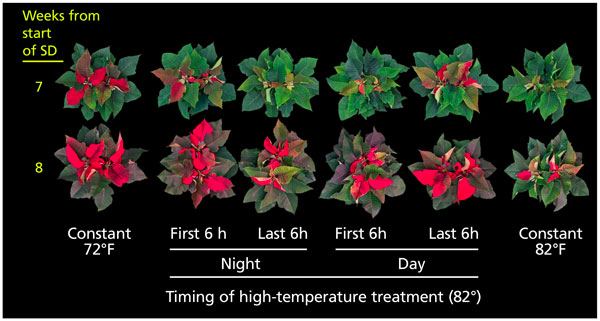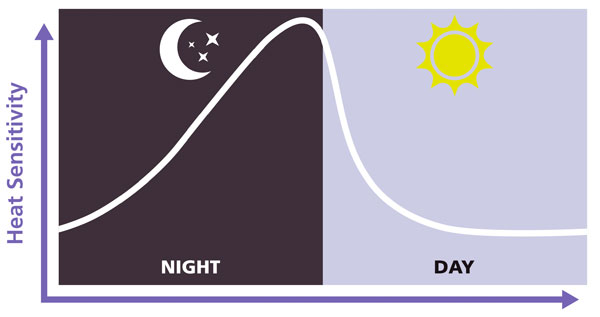8/1/2022
Poinsettia Heat Delay
Paul Millar & James E. Faust
High temperatures during the poinsettia production season can cause delays to cyathia and bract color formation leading to missed market dates and reduced plant quality. Knowing the specific time in which plants are most sensitive to heat delay allows growers to improve greenhouse temperature management and avoid heat delay.
Last month, we identified the weeks in the production season that poinsettias are most sensitive to high temperatures. In this article, we’ll go into further detail, identifying specific hours within a 24-hour day that high temperatures are most likely to cause heat delay.
Poinsettias’ heat-sensitive time
Poinsettias begin floral initiation when the night length is ~12 hours, which naturally occurs from mid-September to early-October in the continental U.S., and these are the critical weeks to avoid high temperatures. During this time, day or night temperatures at ~82F (27C) will cause delayed flowering for heat-sensitive cultivars. Our previous work has shown that poinsettias initiated under black cloth systems (14- to 15-hour night lengths) are much less sensitive to high temperatures, and are sensitive to high temperatures only during the night.
Many plant processes are influenced by daily, clock-like fluctuations—termed circadian rhythms—that are entrained to light and dark cycles. So the next question that we sought to answer was: Under natural photoperiodic conditions, is there a specific time during the day and/or night that poinsettias are particularly sensitive to high temperatures? The answer to this question should allow growers to more effectively avoid high temperatures during the most sensitive periods of the day and/or night.
To accomplish this, we conducted an experiment utilizing two growth chambers—a moderate-temperature growth chamber maintained at 72F (22C) and a high-temperature growth chamber maintained at 82F (27C). Both growth chambers were fitted with LED fixtures, which provided a consistent 12-hour night length.
High-temperature treatments were applied by moving groups of plants from the moderate-temperature growth chamber to the high-temperature growth chamber at specific times within the 24-hour cycle. High temperatures were applied for either the first or last six hours of either the night or day period. These treatments were delivered during the first two weeks of short days (12-hour night lengths) since this is the most sensitive stage of flowering. Additionally, two groups of plants were kept for the entire two weeks in either the moderate- and high-temperature growth chamber to act as control groups. This experiment was conducted on the poinsettia cultivar Prestige, which is known to be highly susceptible to heat delay.
 Our results show that the last six hours of the night is the time when poinsettias are most sensitive to high temperatures within a 24-hour cycle (Figure 1). In fact, high temperatures applied for just six hours at the end of the night caused an equal amount of delay compared to high temperatures applied for the entire 24-hour period. The first six hours of the day was also a sensitive time, although to a lesser extent than the last six hours of the night.
Our results show that the last six hours of the night is the time when poinsettias are most sensitive to high temperatures within a 24-hour cycle (Figure 1). In fact, high temperatures applied for just six hours at the end of the night caused an equal amount of delay compared to high temperatures applied for the entire 24-hour period. The first six hours of the day was also a sensitive time, although to a lesser extent than the last six hours of the night.
Figure 1. The effect of high temperatures (82F/27C) delivered during different hours within a 24-hour cycle for Prestige Red Poinsettias. Note that the plants placed at 82F for the last six hours of the night have delayed flowering comparable to the plants grown continuously 24 hours a day at 82F.
In contrast, high temperatures during the first six hours of the night and last six hours of the day resulted in little to no heat delay. Therefore, the first six hours of the night and the last six hours of the day were determined to be the least-sensitive times within a 24-hour period to high temperatures. The relative sensitivity to high temperatures over a 24-hour cycle is demonstrated in Figure 2.
 Figure 2. Relative sensitivity to heat delay fluctuates throughout a 24-hour cycle. The most sensitive time is the last six hours of the night followed by the first six hours of the day.
Figure 2. Relative sensitivity to heat delay fluctuates throughout a 24-hour cycle. The most sensitive time is the last six hours of the night followed by the first six hours of the day.
These results are actually good news for growers, as the end of the night and the beginning of the day are the coolest times of the day and thus the easiest time of day to manage temperature. In most greenhouses, the exhaust fans and cooling pads run during the afternoon and into the first hours of the night, but then shut off during the latter part of the night and early morning. Our results suggest that it’s during these times that maximum cooling should be prioritized, so growers may want to reconsider their programmed temperature setpoints during the late night and early morning.
In our previous article, we determined that the most critical weeks to avoid heat delay are from mid-September to mid-October. Early-season cultivars are likely to be most sensitive towards the middle of September, while mid-season cultivars are more sensitive in mid to late September. Late-season cultivars have a period of sensitivity that starts in late September and continues into early October. Heat-tolerant cultivars are typically sensitive for just one to two weeks, while heat-sensitive cultivars may be sensitive for four or more weeks. Mid-September through early October is a relatively long window in which to maintain moderate greenhouse temperatures, but this is made more manageable by prioritizing greenhouse cooling during the late night and early morning hours as suggested in this article.
What temperatures are most concerning? We know that 75F (24C) is a safe temperature and 82F (27C) is not, but we don’t have data at any other temperatures. We suspect that you’ll see a gradual increase in heat delay as temperatures increase from 75 to 82F. At 82F, we’ve observed roughly a one-day delay in flowering for every day that the plants are placed at this temperature during the last six hours of the night. This is true during the peak weeks of sensitivity, but as flower development proceeds, the plants become progressively less sensitive, so that high temperatures shouldn’t be a problem on most cultivars beyond mid-October.
In addition, growers should utilize other tools at their disposal for mitigating the risk of heat delay starting with the selection of heat-tolerant cultivars. While our studies suggest that no cultivars are entirely immune to the effects of heat delay, there are many cultivars that demonstrate significantly more tolerance than others. In recent years, breeders have assessed their cultivars for heat delay and can make reliable recommendations for different climates across the U.S.
Lastly, growers should consider the use of blackout curtains to increase night lengths since poinsettias are less sensitive to heat delay when night lengths are 14 to 15 hours. GT
The authors thank the USDA-ARS Floriculture & Nursery Research Initiative for their financial support of this project.
Paul Millar recently finished his MS degree at Clemson University and now works at the Clemson University Research and Extension Center in Charleston, South Carolina. James Faust is a professor at Clemson University.